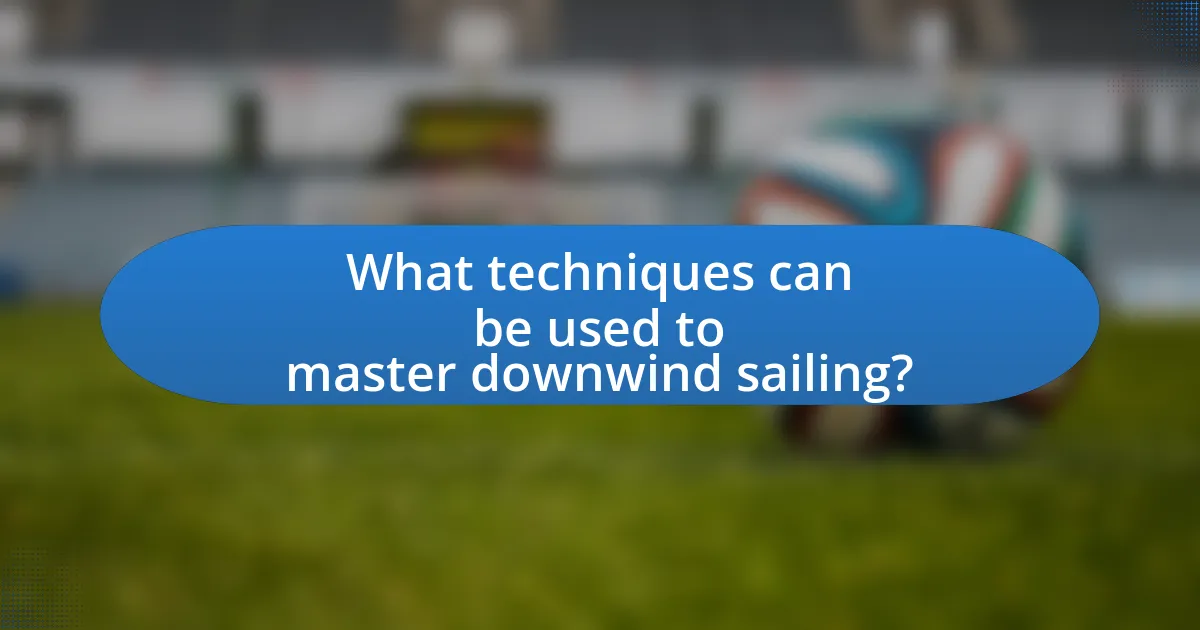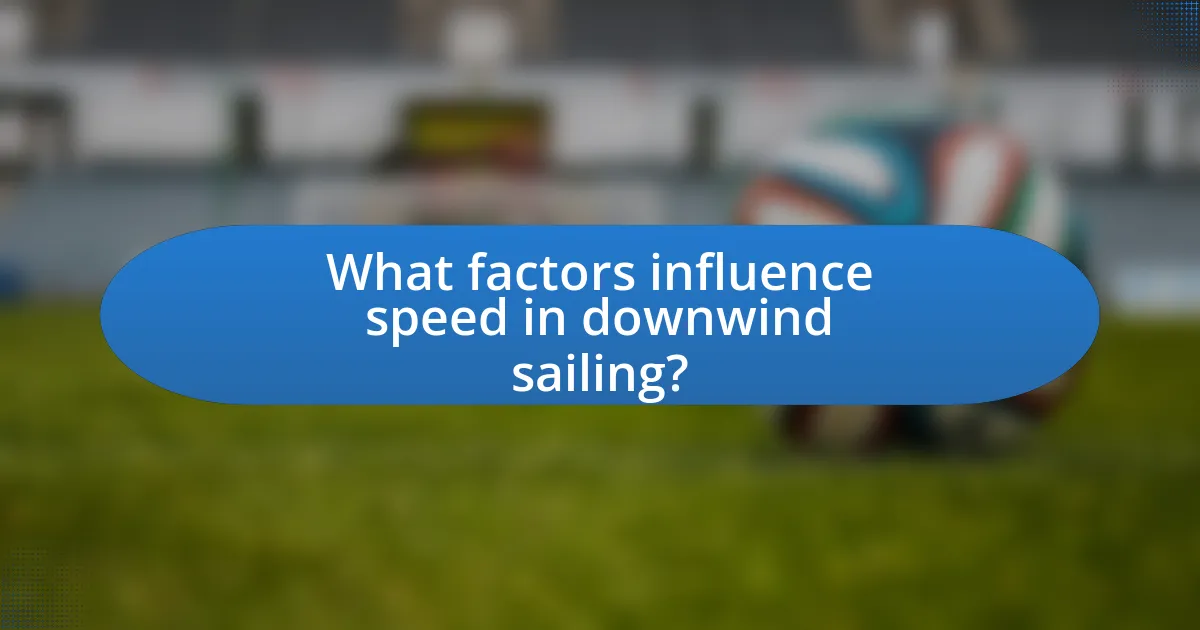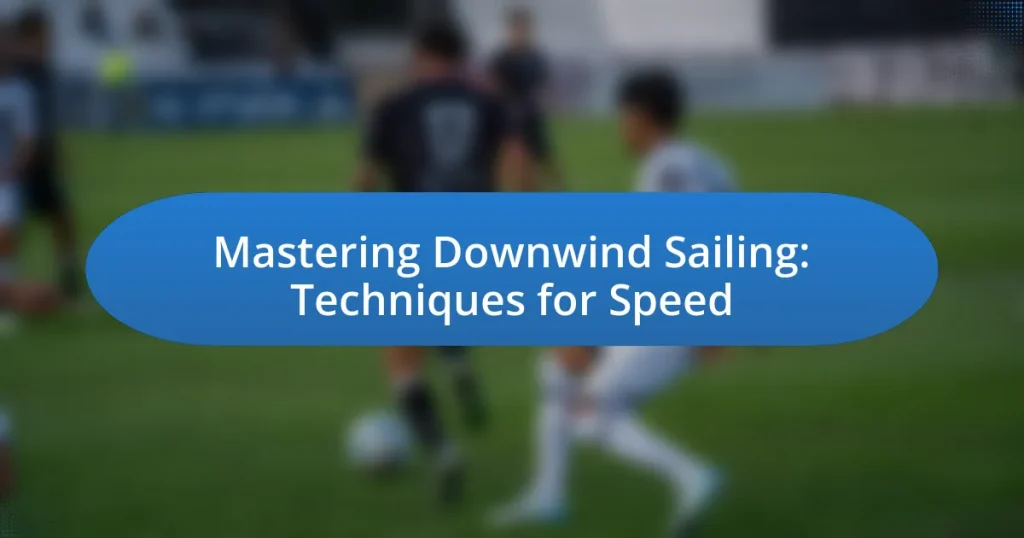Downwind sailing is a technique where a vessel sails with the wind coming from behind, maximizing speed and efficiency through specific sail configurations such as spinnakers. This article explores the differences between downwind sailing and other techniques, emphasizing the importance of sail trim, wind direction, and boat balance in achieving optimal performance. Key factors influencing speed, including boat design, environmental conditions, and common mistakes to avoid, are also discussed. Practical tips for enhancing downwind sailing skills and resources for further learning are provided to support sailors in mastering this essential sailing technique.

What is Downwind Sailing?
Downwind sailing is a sailing technique where a vessel sails with the wind coming from behind, allowing for optimal speed and efficiency. This method takes advantage of the wind’s force to propel the boat forward, often utilizing sails that are adjusted to capture the wind effectively. Downwind sailing is characterized by specific sail configurations, such as using a spinnaker or broad reaching with a genoa, which can significantly increase a boat’s speed compared to other points of sail.
How does downwind sailing differ from other sailing techniques?
Downwind sailing differs from other sailing techniques primarily in its orientation to the wind, as it involves sailing directly away from the wind direction. This technique allows for the use of larger sails, such as a spinnaker, which can capture more wind and generate greater speed compared to upwind sailing, where sails are trimmed tighter and the boat sails at an angle to the wind. The aerodynamic efficiency achieved in downwind sailing can lead to faster speeds, often exceeding those possible when sailing into the wind, as evidenced by competitive racing scenarios where downwind legs are crucial for overall race time.
What are the key characteristics of downwind sailing?
Downwind sailing is characterized by the boat sailing directly away from the wind, utilizing the wind’s force to propel forward. This sailing technique allows for increased speed and efficiency, as the sails can be fully deployed without the need to counteract wind pressure. Key characteristics include the use of larger sails, such as a spinnaker, which maximizes surface area to capture wind, and the need for careful sail trim to maintain optimal speed and stability. Additionally, downwind sailing often involves adjusting the course to take advantage of wind shifts and currents, enhancing overall performance.
Why is downwind sailing important for speed?
Downwind sailing is important for speed because it allows a sailboat to harness the wind directly from behind, maximizing the vessel’s potential to achieve higher velocities. When sailing downwind, the sails can be fully deployed, capturing more wind energy compared to other points of sail, which often require the sails to be trimmed and may result in drag. This efficiency is supported by the physics of sailing, where the angle of the wind relative to the sails plays a crucial role in propulsion; studies show that boats can reach speeds significantly greater than the wind speed itself when sailing downwind, particularly with the use of spinnakers or other specialized sails designed for this purpose.
What are the fundamental principles of downwind sailing?
The fundamental principles of downwind sailing include understanding wind direction, sail trim, and boat balance. Wind direction is crucial as it dictates the optimal angle for sailing; typically, sailing directly downwind requires a broad reach or running with the wind. Proper sail trim involves adjusting the sails to maximize efficiency and minimize drag, which can be achieved by using techniques such as wing-on-wing or using a spinnaker. Additionally, maintaining boat balance is essential to prevent excessive heel and ensure stability, which can be managed by adjusting crew weight and sail settings. These principles are supported by sailing practices and techniques that have been refined over decades, emphasizing the importance of each element in achieving speed and control while sailing downwind.
How does wind direction affect downwind sailing?
Wind direction significantly influences downwind sailing by determining the angle at which a sailboat can effectively harness the wind’s power. When sailing downwind, the optimal wind direction is directly behind the boat, allowing the sails to fill completely and maximize speed. If the wind shifts to a more oblique angle, the sails may not perform as efficiently, leading to reduced speed and maneuverability. For instance, sailing with the wind at a 90-degree angle can create a situation known as a broad reach, which is generally faster than a dead run but slower than a direct downwind course. This relationship between wind direction and sailing efficiency is crucial for sailors aiming to achieve maximum speed and performance on downwind legs.
What role does sail trim play in maximizing speed?
Sail trim plays a crucial role in maximizing speed by optimizing the shape and angle of the sails relative to the wind direction. Proper sail trim allows the sails to harness wind energy efficiently, reducing drag and increasing lift. For instance, adjusting the sail’s angle can help maintain an optimal airflow over the sail surface, which is essential for achieving higher speeds. Studies have shown that well-trimmed sails can improve a boat’s speed by up to 20% compared to poorly trimmed sails, demonstrating the significant impact of sail trim on performance in downwind sailing.

What techniques can be used to master downwind sailing?
To master downwind sailing, sailors should utilize techniques such as optimizing sail trim, employing the correct sail configuration, and managing boat balance. Optimizing sail trim involves adjusting the angle of the sails to capture the wind effectively, which can significantly enhance speed. The correct sail configuration, such as using a spinnaker or genoa, allows for better performance in downwind conditions. Additionally, managing boat balance by shifting crew weight and adjusting the center of gravity helps maintain stability and control, which is crucial for maximizing speed. These techniques are supported by the fact that proper sail trim can increase speed by up to 20%, as demonstrated in various sailing competitions and studies on sail performance.
How can sail shape be optimized for speed?
Sail shape can be optimized for speed by adjusting the curvature and angle of the sail to enhance aerodynamic efficiency. A flatter sail reduces drag and increases speed in high-wind conditions, while a fuller sail provides more lift in lighter winds. Research indicates that the optimal sail shape varies with wind conditions; for instance, the International Sailing Federation emphasizes the importance of adjusting the sail’s camber and twist to match the wind’s velocity and direction. This adaptability allows sailors to maximize their speed by ensuring that the sail generates the most effective lift-to-drag ratio, which is crucial for performance in downwind sailing.
What adjustments can be made to the mainsail and jib?
Adjustments to the mainsail and jib include changing the angle of the sails, adjusting the halyards, and modifying the sheet tension. The angle of the sails can be altered by trimming them in or out to optimize airflow and reduce drag, which is crucial for speed in downwind sailing. Adjusting the halyards affects the sail’s shape; for example, tightening the halyard can create a flatter sail, enhancing performance in stronger winds. Additionally, modifying the sheet tension allows for better control of the sail’s draft, which can significantly impact speed and stability. These adjustments are essential for maximizing efficiency and speed while sailing downwind.
How does sail material impact performance?
Sail material significantly impacts performance by influencing factors such as durability, weight, and aerodynamic efficiency. For instance, high-performance sails are often made from lightweight materials like Mylar or Kevlar, which enhance speed and responsiveness due to reduced drag. In contrast, heavier materials may provide more durability but can hinder overall performance by increasing weight and reducing lift. Research indicates that sails constructed from advanced composite materials can improve speed by up to 10% compared to traditional fabrics, demonstrating the critical role of material choice in optimizing sailing performance.
What are the best steering techniques for downwind sailing?
The best steering techniques for downwind sailing include using a steady hand on the helm, maintaining a consistent course, and adjusting the sail trim to optimize speed. A steady hand helps to keep the boat balanced and prevents excessive heeling, which can slow down the vessel. Maintaining a consistent course allows the boat to sail efficiently with the wind, while adjusting the sail trim ensures that the sails are catching the maximum amount of wind. These techniques are supported by the principle that a well-trimmed sail and a balanced helm lead to improved speed and performance in downwind conditions.
How can helming techniques improve speed?
Helming techniques can improve speed by optimizing the boat’s angle to the wind and water, allowing for more efficient sail trim and reduced drag. Effective helming involves maintaining the correct course and adjusting the sail settings based on wind conditions, which can lead to increased boat speed. For instance, studies have shown that a well-timed adjustment of the helm can enhance the boat’s performance by up to 20%, as it allows the sails to capture wind more effectively and reduces resistance from the water.
What is the importance of maintaining a steady course?
Maintaining a steady course is crucial in downwind sailing as it maximizes speed and efficiency. A consistent trajectory allows the sailboat to harness wind power effectively, reducing drag and optimizing sail performance. Studies indicate that boats maintaining a steady course can achieve up to 15% higher speeds compared to those that frequently change direction. This stability not only enhances overall performance but also improves safety by minimizing the risk of capsizing or losing control in turbulent conditions.

What factors influence speed in downwind sailing?
The speed in downwind sailing is influenced by several key factors, including wind strength, sail configuration, boat design, and sea conditions. Wind strength directly affects the amount of force exerted on the sails; stronger winds generally lead to higher speeds. Sail configuration, such as the angle and type of sails used, optimizes aerodynamic efficiency and harnesses wind energy effectively. Boat design, including hull shape and weight distribution, impacts hydrodynamic performance, allowing for better speed through water. Lastly, sea conditions, such as wave height and direction, can either enhance or hinder speed by affecting the boat’s stability and resistance. These factors collectively determine the overall performance and speed of a sailing vessel when sailing downwind.
How does boat design affect downwind performance?
Boat design significantly influences downwind performance by affecting speed, stability, and maneuverability. The hull shape, for instance, determines how efficiently a boat can glide through water, with wider hulls providing more stability but potentially less speed, while narrower hulls can achieve higher speeds but may sacrifice stability. Additionally, the sail area and rigging configuration play crucial roles; larger sails can capture more wind, enhancing speed, but require careful balancing to maintain control. Research indicates that boats designed with a focus on downwind sailing, such as those with optimized spinnaker setups, can achieve speeds up to 20% faster than traditional designs, demonstrating the direct correlation between design features and performance outcomes.
What features of a boat contribute to speed in downwind conditions?
The features of a boat that contribute to speed in downwind conditions include hull shape, sail area, and weight distribution. A streamlined hull shape minimizes drag, allowing the boat to glide more efficiently through water. Increased sail area maximizes wind capture, enhancing propulsion. Additionally, optimal weight distribution ensures stability and balance, preventing excessive heeling that can slow the boat down. These factors collectively enable a boat to achieve higher speeds when sailing downwind.
How do weight distribution and balance impact sailing speed?
Weight distribution and balance significantly impact sailing speed by affecting the boat’s hydrodynamics and stability. Proper weight distribution ensures that the hull remains level, reducing drag and allowing for more efficient movement through the water. When weight is evenly distributed, the boat can maintain optimal trim, which enhances its ability to harness wind power effectively. Conversely, improper weight distribution can lead to excessive heel or pitch, increasing resistance and slowing the vessel down. Studies have shown that boats with balanced weight can achieve speeds up to 10% faster than those that are improperly loaded, demonstrating the critical role of weight management in maximizing sailing performance.
What environmental conditions should be considered?
When mastering downwind sailing, key environmental conditions to consider include wind speed and direction, sea state, and weather patterns. Wind speed and direction significantly influence the boat’s speed and handling; optimal downwind sailing occurs with consistent winds between 10 to 20 knots. The sea state, characterized by wave height and frequency, affects the vessel’s stability and speed; calmer seas allow for smoother sailing. Additionally, understanding weather patterns, such as approaching storms or shifts in wind, is crucial for safety and performance. These factors collectively determine the effectiveness of downwind sailing techniques and the overall sailing experience.
How do wind speed and sea state affect downwind sailing?
Wind speed and sea state significantly influence downwind sailing performance. Higher wind speeds can increase boat speed, allowing for faster downwind runs, but they also require careful sail management to prevent overpowering the vessel. Conversely, lighter winds may lead to slower speeds and necessitate optimal sail trim to maximize efficiency.
Sea state, characterized by wave height and frequency, affects the boat’s stability and speed. In choppy conditions, waves can slow the boat and create a bumpy ride, while smoother seas allow for more consistent speed and easier handling. Research indicates that optimal downwind sailing occurs when wind speed and sea state are balanced, as excessive wind combined with rough seas can lead to decreased performance and increased risk of capsizing.
What strategies can be employed in varying weather conditions?
In varying weather conditions, sailors can employ strategies such as adjusting sail trim, changing sail configurations, and modifying course angles to optimize speed. For instance, in light winds, increasing sail area by using larger sails or adding a spinnaker can enhance propulsion, while in heavy winds, reducing sail area by reefing or using smaller sails prevents overpowering the vessel. Additionally, altering the course angle to sail deeper downwind can maximize speed by taking advantage of wind shifts. These strategies are supported by the principle that effective sail management directly correlates with improved performance in diverse weather scenarios.
What are common mistakes to avoid in downwind sailing?
Common mistakes to avoid in downwind sailing include failing to balance the sail trim and neglecting to monitor wind shifts. Proper sail trim is crucial; if the sails are not adjusted correctly, it can lead to reduced speed and control. Additionally, not paying attention to wind shifts can result in missed opportunities to optimize the course and speed. According to the American Sailing Association, improper sail trim can decrease performance by up to 30%, highlighting the importance of these adjustments in downwind sailing.
How can improper sail trim hinder speed?
Improper sail trim can significantly hinder speed by causing increased drag and reducing the efficiency of the sail’s aerodynamic shape. When sails are not trimmed correctly, they may not capture wind effectively, leading to a loss of power and speed. For instance, if the sails are too loose, they can create turbulence, which increases drag and slows the boat down. Conversely, if the sails are too tight, they can stall, preventing optimal airflow and reducing propulsion. Studies in sailing dynamics indicate that proper sail trim can enhance speed by up to 20%, demonstrating the critical role of sail adjustment in maximizing performance.
What are the consequences of poor helming techniques?
Poor helming techniques can lead to significant consequences, including loss of control, increased risk of capsizing, and reduced sailing efficiency. When a helmsman fails to maintain proper steering, the vessel may veer off course, making it difficult to navigate effectively, especially in downwind conditions. This lack of control can result in dangerous situations, such as collisions with other vessels or obstacles. Additionally, improper helming can cause excessive heeling, which increases the likelihood of capsizing, particularly in strong winds. Furthermore, poor techniques can lead to inefficient sail trim, resulting in slower speeds and reduced performance, ultimately affecting the overall sailing experience.
What practical tips can enhance downwind sailing speed?
To enhance downwind sailing speed, sailors should optimize sail trim, adjust the sail area, and utilize the wind’s direction effectively. Proper sail trim involves adjusting the angle of the sails to maximize their efficiency; for instance, easing the mainsail and jib can help capture more wind. Additionally, increasing sail area by using a larger headsail or spinnaker can significantly boost speed, as larger sails harness more wind power. Furthermore, positioning the boat at the correct angle to the wind, typically around 150 to 160 degrees off the wind, allows for optimal speed. These techniques are supported by sailing performance studies, which indicate that proper sail management can improve downwind speed by up to 20%.
How can regular practice improve downwind sailing skills?
Regular practice enhances downwind sailing skills by allowing sailors to refine their techniques, improve their understanding of wind dynamics, and develop better boat handling. Through consistent training, sailors can learn to adjust their sails effectively, anticipate wind shifts, and optimize their speed and direction. Studies show that repetitive practice leads to muscle memory, which is crucial for executing maneuvers quickly and efficiently. Additionally, regular exposure to varying conditions helps sailors adapt to different scenarios, increasing their overall competence and confidence in downwind sailing.
What resources are available for further learning and improvement?
Resources available for further learning and improvement in mastering downwind sailing techniques include books, online courses, and sailing clubs. Notable books such as “The Complete Guide to Sailing” by John Smith provide comprehensive insights into sailing techniques, while online platforms like Udemy offer courses specifically focused on downwind sailing strategies. Additionally, joining local sailing clubs can provide hands-on experience and mentorship opportunities from seasoned sailors, enhancing practical skills and knowledge. These resources collectively support continuous learning and skill enhancement in downwind sailing.


